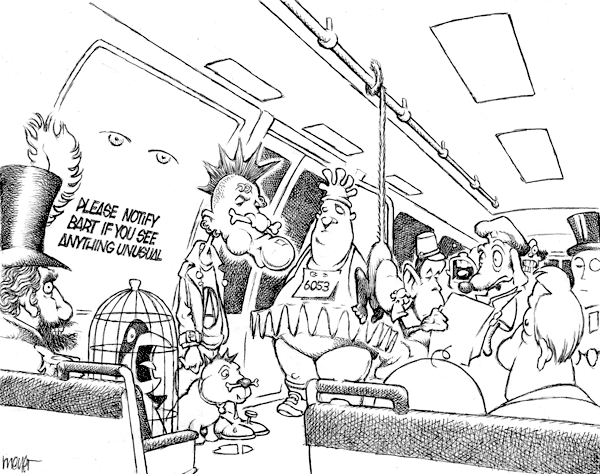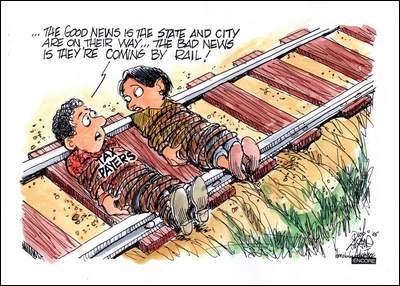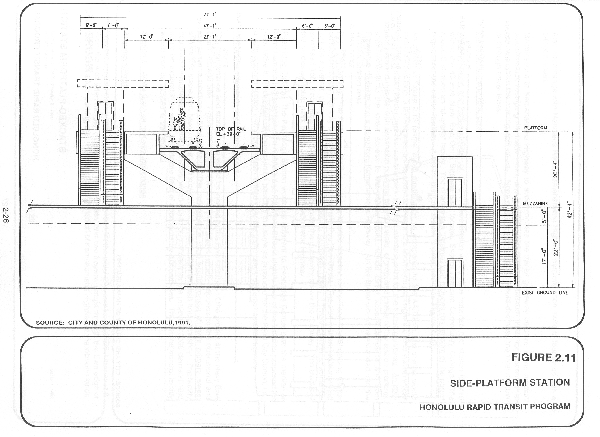honolulutraffic.com
formerly The Alliance for Traffic Improvement
Seeking cost effective ways to reduce traffic congestion on Oahu
![]() August 31,
2005
August 31,
2005
City picks PB for the Alternatives Analysis:
Unsurprisingly, since they are almost the only choice, the City picked Parsons Brinckerhoff for its $9.7 million transit study. PB had earlier handled both the 1992 rail study and also the study for the now defunct BRT program. PB hopes to produce a preliminary list of alternatives by November this year and detailed estimates of costs and ridership in April 2006. READ MORE
Interestingly, PB wrote in the MIS/Draft EIS of the Bus/Rapid Transit(BRT) program of August 2000 that, “The light rail transit alternative was dropped because subsequent analyses revealed that Bus/Rapid Transit using electric-powered vehicles could accomplish virtually all of the objectives of light rail transit at substantially less cost.” Bear in mind that HOT lanes are a BRT variant.
![]() August 30,
2005
August 30,
2005
GAO reports on transit forecasts; riders down, costs up:
A recent GAO report says that, "Initial results from an ongoing study of New Starts projects by FTA show that nearly half of the 19 projects, for which ridership was reviewed, will achieve less than two-thirds of forecast ridership by the forecast year. In addition, costs escalated on 16 of the 21 projects reviewed from the alternatives analysis stage, where decisions are made to go forward with a preferred alternative, to the completion of the project—with 4 of those projects experiencing increases of between 10 and 20 percent and 9 projects with increases over 20 percent." READ MORE
The last word on highways and "induced travel":
One of the issues that stops highway improvements is the idea that adding highways induces new automobile trips (as much as a 10 percent increase in highway capacity inducing a 9 percent increase in traffic) thus nullifying the highway investment. Robert Cervero, Professor of Urban and Regional Planning at UC-Berkeley, has revisited the issue and concludes that earlier studies had significantly overestimated the inducement effect and that it is closer to a 10 percent increase in highways inducing a 4 percent increase in traffic. As he puts it, "Road investments by themselves do not increase volumes. Only by conferring a benefit, like faster speeds, will traffic increase. Adding a twelve-foot lane along a congested urban corridor matters; adding one in a lightly trafficked exurban stretch does not."
He concludes, "Although I personally sympathize with the aims of many environmentalists, fighting highway projects, regardless what benefit-cost numbers say, is misguided. The problems people associate with roads—e.g., congestion and air pollution—are not the fault of road investments per se. These problems stem from the use and mispricing of roads, new and old alike. They also stem from the absence of careful land use planning and management around new interchanges and along newly expanded highways. Better road pricing and land use planning are more likely to achieve the aims of environmentalists than carte blanche bans on any and all road construction."READ MORE
![]() August 26,
2005
August 26,
2005
Houston Chronicle details light rail woes:
The cold statistics about public transportation's declines are one thing. Newspaper acccounts of the problems that public transit faces are another. Houston's light rail line has had so many accidents it is know locally as the Wham Bam Tram. READ MORE
![]() August 24,
2005
August 24,
2005
City's HOT air about HOT lanes:
At yesterday’s media event
for the signing of Bill 40, the Mayor issued “The Facts Behind
HOT Lanes,” a two-page commentary on the HOT lanes proposal.
Public Transportation and Quality of Life:
It seems as though only elected officials can equate Public Transportation and Quality of Life. The San Francisco Chronicle's cartoonist captured this thought quite well last week.

![]() August 13,
2005
August 13,
2005
Mayor says it all about the Alternatives Analysis process:
Here's a quote from Channel 9 News: "The mayor is expected to form a transit advisory committee to guide the consultant as to which project idea it wants to pursue." Wonder what that could be?
Mayor to announce consultant soon:
During the week of August 22nd, the Mayor is expected to formally announce the hiring of Parsons, Brinckerhoff (shhh! keep it to yourself) as the principal consultant for the project. They were also the City's consultants for the In-Town BRT program and the 1992 rail project, among many others.
![]() August 12,
2005
August 12,
2005
Seattle Monorail twists slowly in the wind:
Seattle was to have the nation's first serious urban monorail; the others are all in theme parks and shopping centers — see listing of the Monorail Society. As the costs mount voters are turning against Seattle's monorail and it now appears to be in its death throes. READ MORE
"Wait, wait, did we miss something."
"Wait, what's this rail thing?" Lee Cataluna gets it in today's Advertiser; her column is fun. We have been contending that the state of the rail project is analagous to February in an election year; voters are still not paying attention. Lee captures that perfectly. The voters have not been awakened from their slumbers because the conventional media is still not giving it much coverage and has yet to run a poll on the issue. And maybe that is because everyone understands that we are still in the early stages of the process.READ MORE
![]() August 11,
2005
August 11,
2005
Rail tax bill passes 7-2 as expected — our real work begins:
With
the passage of the tax bill we will now regroup and get ready
for Phase II. The following is a timetable compiled by the Advertiser
staff and this jibes with the Mayor's plan for the initial Kapolei
to Waipahu initial segment : READ MORE
 An optimistic timetable for developing a Kapolei-downtown-UH public transit
system:
An optimistic timetable for developing a Kapolei-downtown-UH public transit
system:
Aug. 22: Mayor Mufi
Hannemann said he will sign tax bill and expects to award $10 million contract
to engineering firm to begin report that chooses the type of transit system and
analyzes impact.
December 2006: Draft environmental impact statement and
alternatives analysis completed.
Jan. 1, 2007: Tax increase
begins.
January 2007-January 2009: Design, final EIS, financing and
bidding.
January 2009: Groundbreaking.
2012: First passenger boards first
phase of transit system. Source: City and County of Honolulu, Advertiser
research.
A typical rail station:
This is from the Supplemental Draft Environmental Impact Statement (SDEIS) the City produced in 1992. It is 58 feet high and 170 wide (SDEIS, page 2-26) and 285 feet long (see SDEIS, page 2-24). The supporting pillars are 9.5 feet square (SDEIS, page 2-26) and are placed at 180 foot intervals (SDEIS, p. 2-24)
Try pacing off these dimensions and you will see how intrusive these stations will be every half-mile in town.

![]() August 5,
2005
August 5,
2005
Excellent commentary by the Advertiser's David Shapiro:
Shapiro makes the point that we are going about it backward to have a tax before there's a plan. As he puts it, "Who is to say that the governor and Legislature won't become skittish and refuse to authorize future tax increases to finish a rail line that the current level of funding will barely start?" He also asks, "We need honest talk about the ultimate cost of rail transit. Even Hannemann admits that the current tax increase will be enough to start the system, but not nearly enough to finish it. What will it ultimately take?" READ MORE
![]() August 4,
2005
August 4,
2005
Reassessment of HOT lanes finds no local tax funding needed:
After extensive discussions with experts such as the designers, builders and public authority for the Tampa Expressway, we have recalculated the local funding needed and find that the Federal funding and the toll revenues are all that is needed. For full details READ MORE
Joint Committee passes the tax 7-2 as expected:
The City Council's Joint Budget and Transportation Committee passed Bill 40, the rail tax, by 7-2 with Barbara Marshall and Charles Djou in opposition. Both ridiculed the idea of having a tax collected before there was a plan. Representative Abercrombie confirmed what we have been saying that while the FTA needs a plan for tax it does not need the tax revenues for many years to come. That did not stop the seven Horsemen of the Apocalypse from voting for it.



